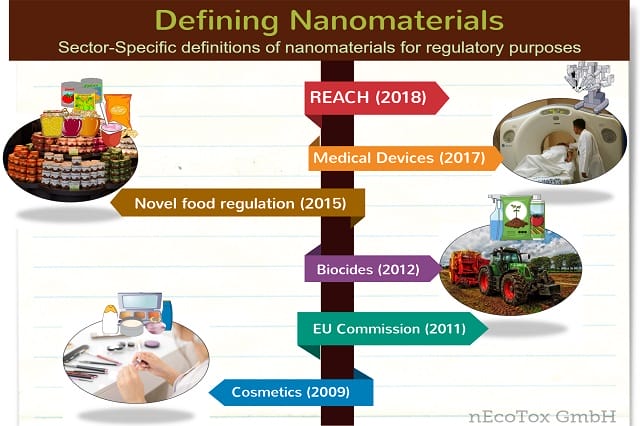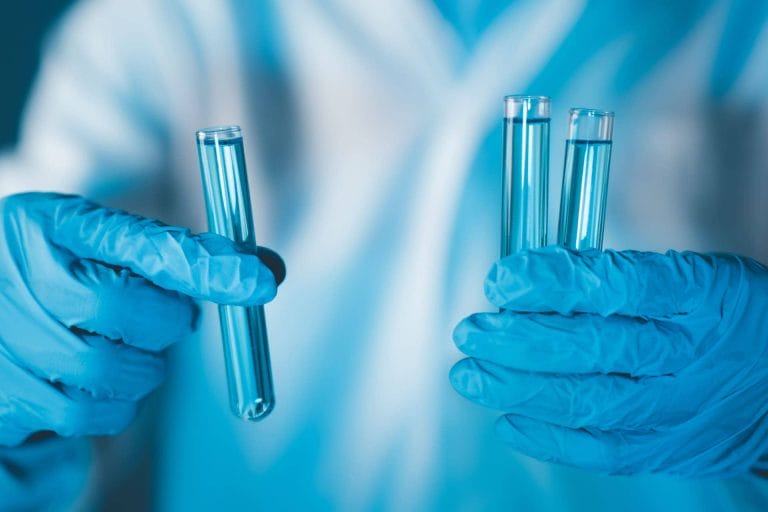Within the EU regulatory framework there are quite a number of different definitions for the term “nanomaterial”. Each of them strongly depends on the field of material application and the respective regulatory legislation.
The Verband der Mineralfarbenindustrie e.V. (VdMi) recently published a document comparing a compilation of relevant nanomaterial definitions in the EUAs part of the document they also highlight respective regulatory consequences from their point of view.
We want to share this – as we think – very helpful compilation of nanomaterial definitions and insights with you. In addition, we provide some further NM associated definition information (where provided; e.g. describing “agglomerates”, “aggregates”, etc.) referring to the following EU regulatory frameworks and the respective reference:
– EU-Commission
– REACH Annex
– Regulation on Cosmetic Products
– Regulation on Biocidal-Products
– Regulation on medical devices
- Regulation on provision of foodinformation
– Novel Food Regulation

The current recommendation of the EU Commission on the definition of a nanomaterial (2011/696/EU), (published 2011) reads as follows:
A natural, random or manufactured material containing particles in an unbound state or as an aggregate or agglomerate and in which, for 50% or more of the particles in the number size distribution, one or more external dimensions are in the size range 1 nm to 100 nm.
In special cases and if justified for environmental, health, safety or competitiveness reasons, the 50% number size distribution threshold may be replaced by a threshold between 1 and 50%.
Notwithstanding, fullerenes, graphene flakes, and single-walled carbon nanotubes with one or more external dimensions less than 1 nm should be considered nanomaterials.
The definition of nanoforms according to the annex of the REACH regulation (1907/2006), published 2018 (EU 2018/1881) and in effect since January 2020 [see Appendix Chapter 3(a)] is documented as follows:
"Based on the Commission Recommendation of October 18, 2011, defining the term 'nanomaterial' (1), a nanoform is a form of a natural or manufactured substance that contains particles in an unbound state or as an aggregate or agglomerate and in which, for 50% or more of the particles in the size distribution, one or more external dimensions are in the size range of 1 nm to 100 nm; this includes, exceptionally, fullerenes, graphene flakes, and single-walled carbon nanotubes with one or more external dimensions less than 1 nm."
The REACH Annex explains the terms "particle", "agglomerate" and "aggregate" in more detail:
"For this purpose, "particle" means a tiny piece of matter with defined physical boundaries; "agglomerate" means a collection of weakly bound particles or aggregates in which the resulting external surface area is similar to the sum of the surfaces of the individual components; and "aggregate" means a particle composed of strongly bound or fused particles."
According to Article 2 "Definitions", paragraph 1 (k) of the Cosmetic Products Regulation (EC1223/2009(published in 2009), nanomaterials are defined as follows:
'Nanomaterial' means an insoluble or biodegradable and intentionally manufactured material with one or more external dimensions or an internal structure on the order of 1 to 100 nm.
The Ordinance on Biocidal Products (EU528/2012 , published in December 2012) defines nanomaterials, particles, agglomerates and aggregates in Article 3, paragraph 1(z) as follows:
Nanomaterial" means a natural or manufactured active or non-active substance that contains particles in an unbound state or as an aggregate or agglomerate and in which at least 50% of the particles in the size distribution have one or more external dimensions in the size range 1-100 nm.
Fullerenes, graphene flakes, and single-walled carbon nanotubes with one or more external dimensions less than 1 nm are considered nanomaterials.
The terms "particle", "agglomerate" and "aggregate" are defined as follows:
- 'Particle' means a tiny piece of matter with defined physical boundaries,
- Agglomerate" means a collection of weakly bound particles or aggregates whose outer surface area is equal to the sum of the surfaces of the individual constituents,
- 'Aggregate' is a particle consisting of strongly bound or fused particles;
The term nanomaterial as well as the terms particle, agglomerate, and aggregation are also used in the context of the Regulation of medical devices [EU 2017/745 : Article 2 "Definitions":(18)-(21)], published in May 2017:
Nanomaterial" means a natural, incidental, or manufactured material containing particles in an unbound state or as an aggregate or agglomerate and in which, for 50% or more of the particles in the size distribution, one or more external dimensions are in the size range of 1-100 nm; fullerenes, graphene flakes, and single-walled carbon nanotubes with one or more external dimensions less than 1 nm are also considered nanomaterials;
Particle" within the meaning of the definition of "nanomaterial" in paragraph 18 is a tiny piece of matter with defined physical limits;
Agglomerate" means, for the purposes of the definition of nanomaterials in paragraph 18, a collection of weakly bound particles or aggregates whose outer surface area is equal to the sum of the surfaces of the individual constituents;
Aggregate" means, for the purposes of the definition of nanomaterials in paragraph 18, a particle consisting of strongly bound or fused particles;
In November 2011, another definition of nanomaterials was added to the Regulation on the provision of food information (EU 1169/2011 , Article 2, paragraph 2 (t)). It is identical to the definition in the Novel Food Regulation (EU 2015/228 3, Article 3, paragraph 2 (f), published in December 2015) and also includes properties characteristic of the nanoscale and reads as follows:
Engineered nanomaterial" means any intentionally manufactured material that has one or more dimensions on the order of 100 nm or less, or that consists of discrete functional parts either internally or on the surface, many of which have one or more dimensions on the order of 100 nm or less, including structures, agglomerates, or aggregates that may have a size greater than 100 nm but retain properties characteristic of the nanoscale.
Properties characteristic of the nanoscale include:
(i) related to the large specific surface area of the materials under consideration; and/or
(ii) specific physicochemical properties that differ from those of the non-nanoform of the same material;"
As mentioned at the beginning: In the EU regulatory framework, there is a whole range of different definitions for the term "nanomaterial". This broad diversity of definitions has different consequences for the regulation of NMs in the respective EU frameworks. In one of our next blog posts, we will discuss a selection of these consequences and refer to corresponding measures that we offer!
Are you looking for an expert in the field of nanotechnology? Contact us by phone: +49 6346 9661490 or via mail!
Last update of this blog entry: February 15, 2021
This blog entry does not permanently claim completeness and timeliness of definitions.




